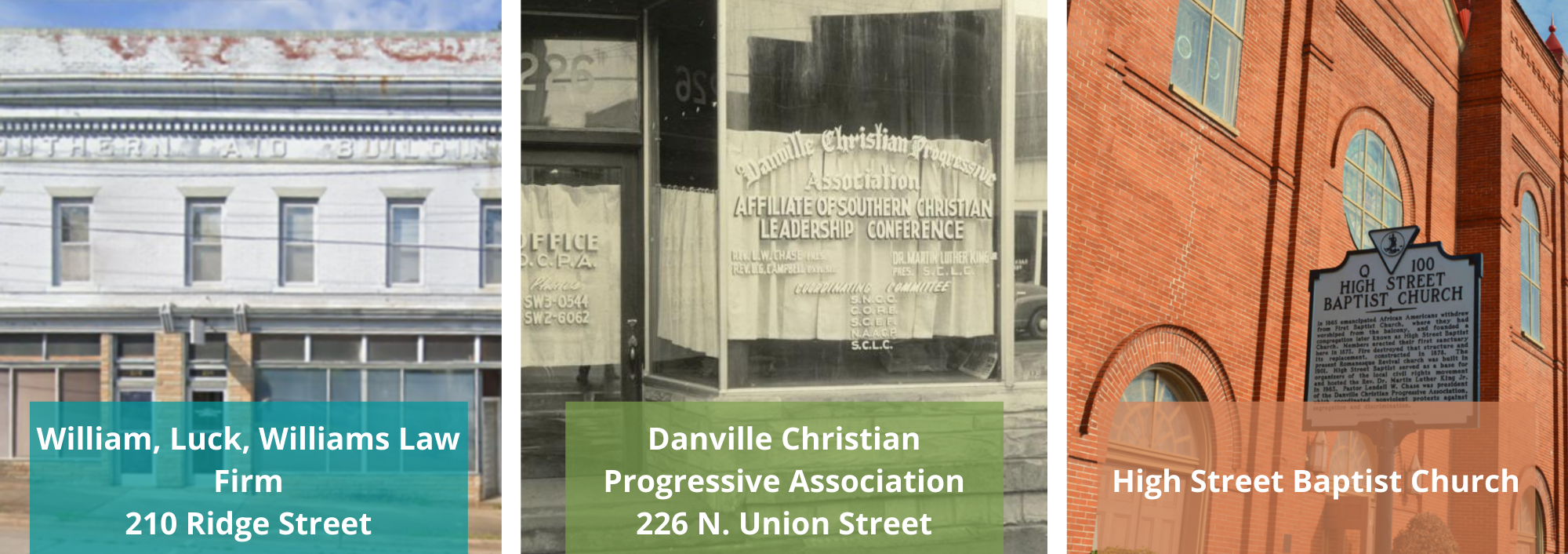
History
Danville and the Civil Rights Movement
Historical Locations:
High Street Baptist Church - (High Street Baptist Church Historic Marker)
226 N.Union Street - The Merritt Building
401 Patton Street - Danville Courthouse (Bloody Monday Historic Marker)
125 N. Floyd Street - City Auditorium
210 Ridge Street - Law Firm of William, Luck, Williams

In the 1960s the Danville, Virginia (specifically High Street, N. Union Street, and Spring Street) was the site of the city’s Black Business District and home to several individuals and organizations dedicated to the Civil Rights Movement in both the City of Danville and throughout the region. Many of the properties located in the area carry a rich history.
One example is the property where the Law Firm of William, Luck, Williams is currently located at 210 Ridge Street. Built in 1916, the building was originally owned by Attorney Jerry Williams Sr., a local Civil Rights attorney and former NAACP president. It is now owned by his son, Attorney Jerry Williams Jr. At the age of 14 Jerry Williams Jr staged a sit in at Ballou Park that would help lead to integration in Danville.
Another important structure, High Street Baptist Church, was a safe haven during the Civil Rights Movement and also plays an important role in history. In early 1963, Rev. Chase of High Street Baptist Church, along with two of his colleagues (Bishop Lawrence G. Campbell of Bibleway Church and Rev. AI Dunlap), formed the Danville Christian Progressive Association (DCPA). The DCPA organized an event on March 26th, 1963 and invited Dr. Martin Luther King, Jr to speak. Dr. King made his remarks that day at Danville City Auditorium to a crowd of more than 2,500; it was here that he stated that Danville had one of the most brutal police forces he had ever seen.
A historic marker next to High Street Baptist Church states: "In 1865 emancipated African Americans withdrew from First Baptist Church, where they had worshiped from the balcony, and founded a congregation later known as High Street Baptist Church. Members erected their first sanctuary here in 1873. Fire destroyed that structure and its replacement, constructed in 1878. The present Romanesque Revival church was built in 1901. High Street Baptist served as a base for organizers of the local civil rights movement and hosted the Rev. Dr. Martin Luther King Jr. in 1963. Pastor Lendell W. Chase was president of the Danville Christian Progressive Association, which coordinated nonviolent protests against segregation and discrimination.” The High Street Baptist Church congregation continues worship services today, and is currently served by Rev. Voight F. Hairston.
The DCPA was housed in the Merrit Building, located at 226 N. Union Street. This building, currently owned by business owner Ameer Nesmith, was built in 1912 and was previously owned by Mr. Bishop Merritt, an African American dentist whom the building was named after. In 1963 the building also housed the office of the Danville Christian Progressive Association (DCPA), who were affiliated with the Southern Christian Leadership Conference (SCLC). The president of SCLC was the late Dr. Martin Luther King, Jr. and this location was the meeting place for Civil Rights groups in 1963. This portion of the building is still intact with the same brick facade from back then.
That same year (1963), protests that took place near City Hall on Patton Street would be remembered as “Bloody Monday” and are recognized by a historical marker on the site at 401 Patton Street. The marker reads "In the spring of 1963 local African American ministers and other leaders organized the Danville Movement to combat widespread racial segregation and discrimination. On 10 June, two demonstrations occurred. Police clubbed and fire-hosed the marchers, injuring at least 47 and arresting 60. The Rev. Dr. Martin Luther King, Jr., offered protestors his “full, personal support” when he arrived in Danville on 11 July. The nonviolent protests, which became known as “Bloody Monday,” gained national news coverage before the 28 Aug. March on Washington co-led by the Rev. Dr. King. Both events swelled sentiment in favor of civil rights legislation."
Information and photos provided by Karice Luck-Brimmer of Our History Matters
A Jewel Worth Saving: Re-imagining Danville’s North Union Street
Danville, Virginia may be best known for the railroad system, including the wreck of the “Old 97,“and a rich textile and tobacco history. But there is a block in downtown Danville, North Union Street, that also has a story of its own.
South Union Street Pocket Park
The S. Union Street Pocket Park is nestled between two wings of The Bee Hotel in Danville, Virginia. The park opened officially to the public on May 12, 2021 with a virtual ribbon cutting ceremony.
Monuments to yesteryear: Restoring downtown Danville buildings adds value, money for the entire community.
Old buildings, rows upon rows of them.
Musty, old-fashioned and usually in dire need of repair.
We have a downtown full of old buildings and they don’t seem to have any life left — just a reminder of generations gone by. Why would anyone spend time trying to bring them back to life? Why don’t we just tear them down?
These are just a few things you hear in this business of revitalizing historic downtowns. It can be hard to understand the value of these monuments to yesteryear. But what if I were to tell you that, by leaving them empty and not taking time and effort to find new uses and bring them back to glory, that our community would be losing funds that could be used for schools, infrastructure and public safety all over the city?

